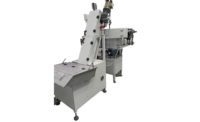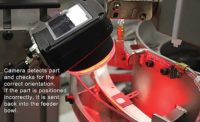Manufacturers of automated machinery often receive requests to feed and orient ordinary plastics caps, but even an ordinary cap can have features that can cause part “behaviors” that present challenges during the feeding process.
Performance Feeders Inc. received a request to feed a plastic cap, 62.59 millimeters in diameter, as part of a medical application. Because it was a high-volume application, the feeding system consisted of a tapered prefeeder bin, a hopper storage bin, and a conical-style vibratory bowl feeder.
The larger diameter of the cap facilitated a locking of the parts within the prefeeder, causing a bridging of parts inside of a hopper. This bridging created hollowed pockets in the part supply within the hopper that reduced the flow of the parts transferring to the cleats of the elevator belt conveying parts into the bowl.
To keep the caps from bridging in the hopper, a pneumatic agitating mechanism was designed into the purge gate of the hopper base to release the locked parts. This mechanism was a large, rectangular piston that created an axis of motion perpendicular to the parts. It pushed up into the caps to disentangle them and maintain a consistent flow of parts to the elevator belt. This helped to ensure that the parts were readily available for the vibratory feeder bowl.
A second challenge was presented as Performance Feeders engineers were assembling the system: The customer had a design change in the features of the part to be fed. The outer dimension of the part was altered, reducing the natural rotation of the transferring part. An addition of an air jet to the selector area of the feeder bowl applied air assistance to rotate the new part into proper orientation. As a result, the engineers were able to feed the altered cap within the same system designed for the original application.
For more information on parts feeders, call 813-855-2685, visit www.performancefeeders.com or email sales@performancefeeders.com.
Editor’s note: “We Fed It” is a regular series profiling parts feeders for automated assembly. Whether it’s a vibratory bowl, a tray feeder or a flexible robotic system, if you’ve solved a parts-feeding challenge, we’d like to hear about it. Send an e-mail to John Sprovieri, chief editor of ASSEMBLY, at sprovierij@bnpmedia.com, or call
630-776-0924.



